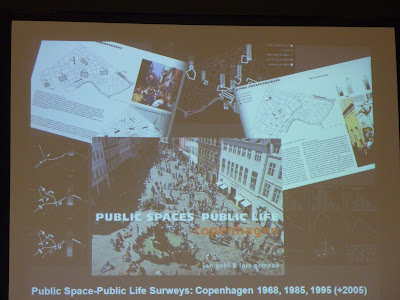Jan Gehl graduated from Architecture in 1960, a time to him represents an all time low point in city planning, when architects were big and people were quite small. After marrying a psychologist he started questioning why architecture solely focused on form and did not focus at all on people? For Jan Gehl, Architecture is the interaction between form and life. Cue Jan Gehl’s one stone, five birds policy. If you are sweet to people it is possible to create Lively, Attractive, Safe, Sustainable, and Healthy cities. Modernism, one of the evil of society according to Mr. Gehl, interpreted cities as bad and buildings as good. 1960, the year he graduated was also the year when post-war reconstruction started big time. At the same time there was an invasion on the city ten years after the war, the car invasion. Of course cheap petroleum fuelled this and all the city planner’s energy went into trying to make the car happy. Using Westport, a small town in the west of Ireland as an example, he argues that as a result of the car invasion, human dignity was being eroded. The ideologies of modernity need to be broken.
The Copenhagen city model of a more people orientated city is now being exported all over the world. Copenhagen is a city that improves a little every day through the use of policies such as the removal of 2% of the car parking spaces in the city each year. The slow and steady change is accepted by the citizens. Many more people now walk in the city because they have been invited to come and walk, sit, enjoy the city. People like people orientated cities and Mr. Gehl states “day by day the city is becoming more and more irresistible”.
The cycle culture created in Copenhagen is a truly wonderful thing. Everyone cycles, from the mayor to politicians and pregnant mothers. In most cites cyclists are predominantly male, aged between 20 - 25 years and dressed in full cycle gear ready for the Tour de France. Cycling is not an extreme sport in Copenhagen, in fact a recent study has revealed that Copenhagen cyclists are predominantly women. By having much less car traffic in the city, cycling becomes open to age groups 5 to 85+. Congestion problems in Copenhagen are now on the bicycle lanes and they have started to widen the bicycle lanes, systematically taking asphalt space from the motortraffic. It’s no reason that the city has been awarded the world’s finest city for people.
When the Copenhagen policy was introduced to Melbourne, the public spaces saw a 40% increase in use by people during the day, and a staggering 400% increase in use during the evening and night time, with 200-300% increase in activities in public space. Mayor Bloomberg of New York has created a vision ‘plaNYC’ to make it the most green of all. Presently there are one million commuting cars travelling into Manhattan each year and they have started construction on over 6,000 kilometres of bicycle lanes throughout the city. In Frank Sinatra’s famous words, If you can make it here you can make it anywhere.
Online video of lecture available from http://media.hum.ku.dk/podcast/podcast_portal/Other speakers at the symposium were:
Klaus Bondam, Mayor in Copenhagen for Technical and Environmental Administration
Yusaku Imamura, Director, Tokyo Wonder Site, Counselor on Special Issue to the Governor, Tokyo Metropolitan Government, Tokyo, Japan
Peter Head, Director, Arup
Sunand Prasad (UK), Immediate Past President, Royal Institute for British Architecture (RIBA) & Senior Partner, Penoyre & Prasad LLP
Mario Cucinella (Italy), Founder Mario Cucinella Architects






